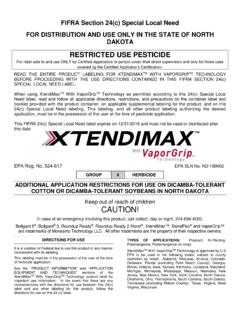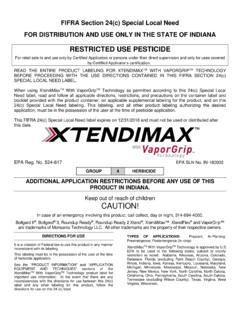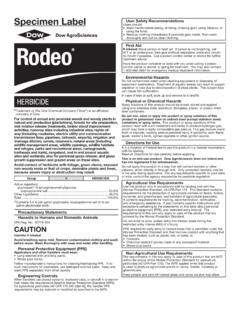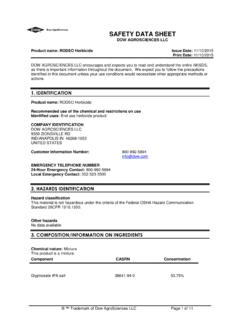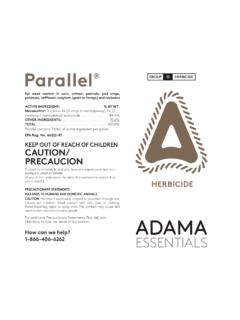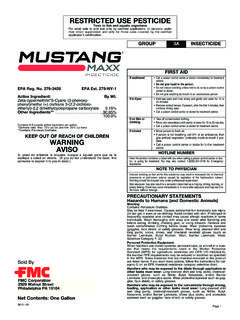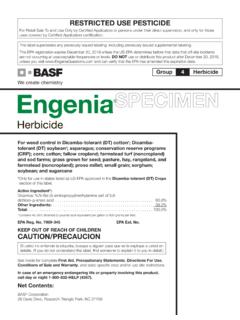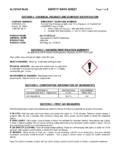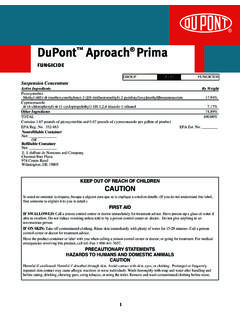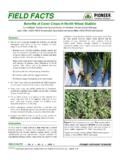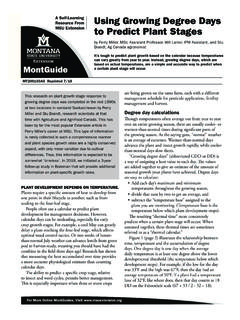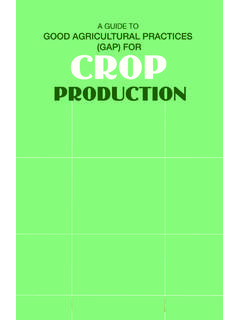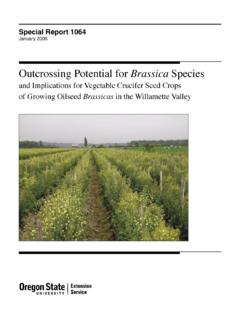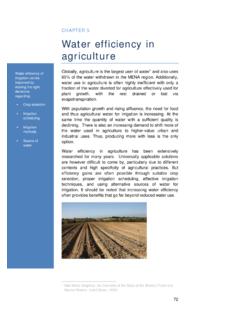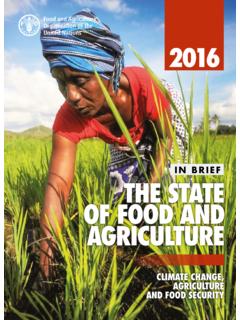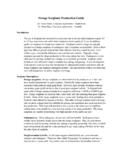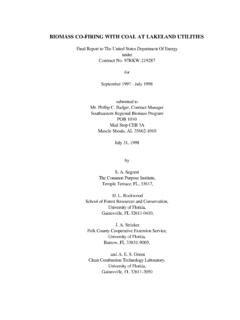Transcription of FOR USE IN SELECTED CROPS - CDMS Home
1 FOR USE IN SELECTED CROPS . Active Ingredient: pendimethalin: N-(1-ethylpropyl)-3,4-dimethyl-2,6-dinit robenzenamine .. Other Ingredients*: .. Total: .. (1 gallon contains pounds of pendimethalin). *Contains aromatic naphtha. EPA Reg. No. 241-337 EPA Est. No. KEEP OUT OF REACH OF CHILDREN. CAUTION/PRECAUCI N. Si usted no entiende la etiqueta, busque a alguien para que se la explique a usted en detalle. (If you do not understand the label, find someone to explain it to you in detail.). See inside for complete First Aid, Precautionary Statements, Directions For Use, Conditions of Sale and Warranty, and state-specific crop and/or use site restrictions. In case of an emergency endangering life or property involving this product, call day or night 1-800-832-HELP (4357). Net Contents: BASF Corporation 26 Davis Drive, Research Triangle Park, NC 27709. Prowl EC herbicide FOR USE IN ALFALFA GROWN FOR SEED PRODUCTION, CORN (FIELD, POP, SEED, SWEET), COTTON, EDIBLE BEANS, FORAGE LEGUMES, GARLIC, GRAIN SORGHUM, LENTILS AND PEAS, NONBEARING FRUIT TREE AND NUT TREE CROPS , NONBEARING.
2 VINEYARDS, ONIONS AND SHALLOTS (DRY BULB), PEANUTS, POTATOES, RICE, SOYBEANS, SUGARCANE, SUNFLOWERS, AND TOBACCO. FIRST AID. Call a poison control center or doctor immediately for treatment advice. DO NOT give any liquid to person. If swallowed DO NOT induce vomiting unless told to do so by a poison control center or doctor. DO NOT give anything by mouth to an unconscious person. Hold eyes open and rinse slowly and gently with water for 15 to 20 minutes. If in eyes Remove contact lenses, if present, after first 5 minutes; then continue rinsing eyes. Call a poison control center or doctor for treatment advice. Take off contaminated clothing. If on skin Rinse skin immediately with plenty of water for 15 to 20 minutes. Call a poison control center or doctor for treatment advice. NOTE TO PHYSICIAN. Because of increased risk of chemical pneumonia or pulmonary edema caused by aspiration of the hydrocarbon solvent, vomiting should be induced only under professional supervision.
3 HOT LINE NUMBER. Have the product container or label with you when calling a poison control center or doctor or going for treatment. You may also contact BASF Corporation for emergency medical treatment information: 1-800-832-HELP (4357). Precautionary Statements User Safety Recommendations HAZARDS TO HUMANS AND DOMESTIC ANIMALS Users should: CAUTION. Causes moderate eye irritation. Harmful if swal- Wash hands before eating, drinking, chewing gum, lowed or absorbed through the skin. Avoid contact with using tobacco, or using the toilet. skin, eyes or clothing. Remove clothing immediately if pesticide gets inside. Wash thoroughly and put on clean clothing. Personal Protective Equipment (PPE) Remove PPE immediately after handling this product. Some materials that are chemical-resistant to this product Wash the outside of gloves before removing. As soon as are listed below. If you want more options, follow the possible, wash thoroughly and change into clean instructions for Category F on an EPA chemical resistance clothing.
4 Category selection chart. Applicators and other handlers must wear: ENVIRONMENTAL HAZARDS. Long-sleeved shirt and long pants This product is toxic to fish. DO NOT apply directly to Chemical-resistant gloves made of waterproof materials, water, or to areas where surface water is present, or to such as barrier laminate, butyl rubber 14 mils, nitrile intertidal areas below the mean high water mark. Drift and rubber 14 mils, neoprene rubber 14 mils, or viton runoff from treated areas may be hazardous to aquatic 14 mils organisms in adjacent aquatic sites. DO NOT contaminate Shoes plus socks water when disposing of equipment washwaters or rinsate. Follow manufacturer's instructions for cleaning/maintaining Endangered Species Protection PPE. If no such instructions for washables, use detergent If endangered plant species occur in proximity to the appli- and hot water. Keep and wash PPE separately from other cation site, the following mitigation measures are required: laundry.
5 If applied by ground, leave an untreated buffer zone of 200 feet. The product must be applied using a low boom Engineering Controls: (20 inches above the ground) and ASAE fine to When handlers use closed systems, enclosed cabs, or air- medium/coarse nozzles. craft in a manner that meets the requirements listed in the Worker Protection Standard (WPS) for agricultural pesti- cides [(40 CFR )(d)(4-6)], the handler PPE require- ments may be reduced or modified as specified in the WPS. 2. If applied by air, leave an untreated buffer zone of AGRICULTURAL USE REQUIREMENTS. 170 feet. Must use straight-stream nozzles (D-6 or larg- er); wind can be no more than 8 mph; and release height Use this product only in accordance with its labeling and must be 15 feet or less. with the Worker Protection Standard, 40 CFR part 170. This standard contains requirements for the protection of To determine whether your county has an endangered agricultural workers on farms, forests, nurseries, and species, consult the website greenhouses, and handlers of agricultural pesticides.
6 It contains requirements for training, decontamination, Endangered Species Bulletins may also be obtained from notification, and emergency assistance. It also contains extension offices or state pesticide agencies. If the bulletin specific instructions and exceptions pertaining to the is not available for your specific area, check with the appro- statements on this label about personal protective equip- priate local state agency to determine if known populations ment (PPE) and restricted-entry interval. The requirements of endangered species occur in the area to be treated. in this box only apply to uses of this product that are cov- ered by the Worker Protection Standard. Directions For Use DO NOT enter or allow worker entry into treated areas It is a violation of federal law to use this product in a man- during the restricted-entry interval (REI) of 24 hours. ner inconsistent with its labeling. This label must be in the Exception: if the product is soil injected or soil incorpo- possession of the user at the time of pesticide application.
7 Rated, the Worker Protection Standard, under certain cir- cumstances, allows workers to enter the treated area if Observe all cautions and limitations in this label and the there will be no contact with anything that has been labels of products used in combination with Prowl EC treated. herbicide. The use of Prowl EC not consistent with this label can result in injury to CROPS , animals, or persons. PPE required for early entry to treated areas that is per- Keep containers closed to avoid spills and contamination. mitted under the Worker Protection Standard and that involves contact with anything that has been treated, DO NOT apply this product in a way that will contact work- such as plants, soil, or water, is: ers or other persons, either directly or through drift. Only Coveralls protected handlers may be in the area during application. Chemical-resistant gloves made of waterproof materials, For any requirements specific to your state or tribe, consult such as barrier laminate, butyl rubber 14 mils, nitrile the agency responsible for pesticide protection.
8 Rubber 14 mils, neoprene rubber 14 mils, or viton DO NOT allow spray to drift from the application site and 14 mils contact people, structures people occupy at any time and Shoes plus socks the associated property, parks and recreation areas, non- target CROPS , aquatic and wetland areas, woodlands, pas- STORAGE AND DISPOSAL. tures, rangelands, or animals. DO NOT contaminate water, food, or feed by storage or disposal. DO NOT enter or allow other people (or pets) to enter the treated area until sprays have dried. PESTICIDE STORAGE: DO NOT STORE BELOW 40 F. Extended storage at temperatures below 40 F can result BASF intends that this product may not be used for manu- in the formation of crystals on the bottom of the container. facturing products for application to turf and ornamentals. If crystallization does occur, store the container on its side BASF does not recommend or authorize the use of this at room temperature (70 F) and rock occasionally until product in manufacturing, processing or preparing custom crystals redissolve.
9 Blends with other products for application to field and row PESTICIDE DISPOSAL: Pesticide wastes are toxic. CROPS or to orchard, grove, and vineyard CROPS . Improper disposal of excess pesticide, spray mixture, or rinsate is a violation of federal law. If these wastes cannot be disposed of by use according to label directions, contact your State Pesticide or Environmental Control Agency, or the Hazardous Waste representative at the nearest EPA Regional Office for guidance. 3. CONTAINER DISPOSAL When this container is empty, replace the cap and seal all Nonrefillable Container. DO NOT reuse or refill this openings that have been opened during use; return the container. Triple rinse or pressure rinse container (or container to the point of purchase or to a designated loca- equivalent) promptly after emptying; then offer for recycling, tion. This container must only be refilled with a pesticide if available, or reconditioning, if appropriate, or puncture product. DO NOT reuse the container for any other pur- and dispose of in a sanitary landfill, or by incineration, or by pose.
10 Prior to refilling, inspect carefully for damage such as other procedures approved by state and local authorities. cracks, punctures, abrasions, worn-out threads and clo- sure devices. Check for leaks after refilling and before Triple rinse containers small enough to shake transport. DO NOT transport if this container is damaged (capacity 5 gallons) as follows: Empty the remaining or leaking. If the container is damaged, or leaking, or obso- contents into application equipment or a mix tank and lete and not returned to the point of purchase or to a des- drain for 10 seconds after the flow begins to drip. Fill the ignated location, triple rinse emptied container and offer for container 1/4 full with water and recap. Shake for 10 recycling, if available, or dispose of container in compliance seconds. Pour rinsate into application equipment or a with state and local regulations. mix tank, or store rinsate for later use or disposal. Drain for 10 seconds after the flow begins to drip.
